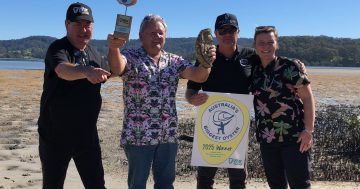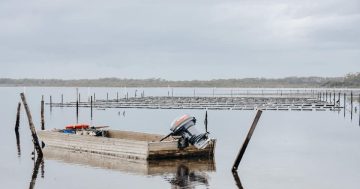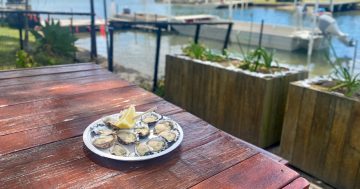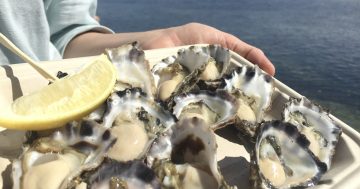
Sue McIntyre and her partner Greg Carton have been hard at work farming oysters on the NSW South Coast for 26 years. Photo: David Rogers Photography.
More than 20 years ago, Sue McIntyre believed she was onto a good thing with oyster farming. And with her farm on Pambula Lake, the proof is in the water.
“Each estuary has its own flavour – it’s a bit like how wine and cheese are influenced by the land that they’re produced on,” she said.
“We’re really lucky Pambula Lake has a balance of freshwater and saltwater.
“We’re open to the Pacific Ocean, but we’ve got the Pambula and Yowaka Rivers that flow in as well, so we’ve got a lovely brackish mix of water that the oysters have been produced in.”
Ms McIntyre is one half of the team at Broadwater Oysters, alongside partner Greg Carton.
With help from their team members, Ms McIntyre said they could grow up to 60,000 dozen mature oysters each year.
“We are lucky enough to grow a native species,” she said.
“These Sydney Rock Oysters are naturally occurring in Pambula Lake, and because of that they spawn and breed naturally in the estuary.”
Getting the oysters to your lunch or dinner table takes months of effort, Ms McIntyre said.
“It’s quite labour intensive and there’s times when you’re out on the water and it’s absolutely beautiful,” she said.
“There’s other times when there is hail and lightning, but you still need to get the job done, so it’s very much a farming enterprise in that way.”
It all starts with male and female oysters, who release spawn into the water.
“The little baby spat float around on the tide for about two weeks to a month until they settle on a growing structure within the estuary,” she said.
“Once we’ve caught them, they grow for about 10 months, and at that point they’re about the size of your fingernail.
“We then take them off and place them into protective baskets for another two years until they’re mature.”

Ms McIntyre said they could grow up to 60,000 dozen mature Sydney Rock Oysters each year. Photo: David Rogers Photography.
But all that action in the water doesn’t mean Ms McIntyre and the team can sit and relax.
“In that time, we are constantly maintaining them and making sure they’re growing to their full potential,” she said.
“We’re doing things like bringing them off the water, emptying them out of their baskets and putting them through a grading machine to sort the different shell sizes and letting their shells dry out to kill bycatch that’s trying to grow on the shell.
“In their whole time on the farm, the oysters get handled about 20 times by the farmers and the farmhands.”
The team at Broadwater Oysters also did more than simply growing oysters, she said.
They sell oysters to the public and also provide restaurants on the South Coast and several seafood brokers in Sydney with their product.
Ms McIntyre said they also offered shucking and gourmet tasting schools for those looking to learn more about the humble oyster.
“We’ve got a diversity of ways that we enter the market with our oysters,” she said.
“We’re really focused on that farm gate interaction with customers.”
Broadwater Oysters are also a participant in the Sapphire Coast Oyster Trail, she said.
Ms McIntyre said that for many, oysters, which were once restricted to seafood platters, were becoming more common.
“Sydney Rock Oysters have been highlighted as a food produce that is really high in a lot of trace minerals, and is particularly good for your immune system and your nervous system,” she said.
“We are finding that people are actively adding them into their diets as a routine thing they eat.”

Broadwater Oysters is located on Pambula Lake. Photo: David Rogers Photography.
Ms McIntyre said the appeal of oysters at Christmas had remained strong.
“Christmas Eve is always a huge day for us,” she said.
“We usually do between 600 to 800 dozen freshly opened oysters for people around town.
“It’s the birthday of our youngest child and it’s our busiest day of the year as well!”
Broadwater Oysters is located at Shed 1, 52 Landing Road in Broadwater, and is open 9 am to 4 pm Tuesday to Friday and 9 am to 3 pm Saturday during winter and spring.














